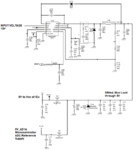FreshmanNewbie
Full Member level 6
There's a 5V DC-DC Regulator in my reference schematic. Step downs from 12V to 5V. Schematic is attached below.
The 5V output is divided into two branches. One 5V branch is the Vcc for some ICs and a microcontroller.
The other 5V branch, is given as the voltage reference for the ADC port in the microcontroller.
Why is this done? Why can't we merge both the 5V output as one?
Maybe because the output 5V which is the Vcc for the other ICs may vary because the load current in that rail may vary?
The 5V output is divided into two branches. One 5V branch is the Vcc for some ICs and a microcontroller.
The other 5V branch, is given as the voltage reference for the ADC port in the microcontroller.
Why is this done? Why can't we merge both the 5V output as one?
Maybe because the output 5V which is the Vcc for the other ICs may vary because the load current in that rail may vary?
